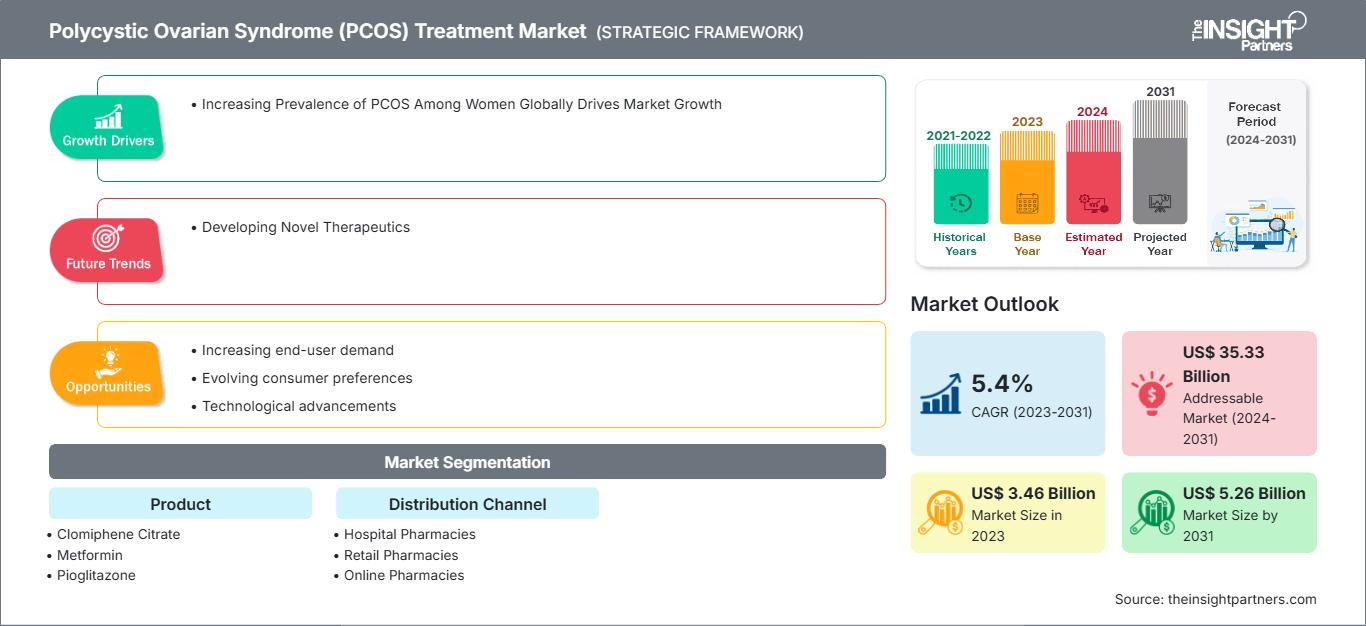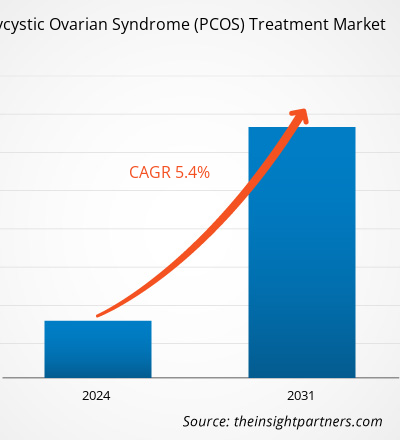Se espera que el mercado de tratamiento del síndrome de ovario poliquístico (SOP) alcance los 7.480 millones de dólares estadounidenses para 2031. Se prevé que registre una tasa de crecimiento anual compuesta (TCAC) del 5,8 % entre 2025 y 2031.
El aumento de la prevalencia del SOP a nivel mundial, sumado al aumento significativo del gasto sanitario en su tratamiento, son los factores que impulsan el crecimiento del mercado de tratamiento del síndrome de ovario poliquístico (SOP). Por ejemplo, aproximadamente 6 millones de mujeres en EE. UU. padecen SOP, un desequilibrio hormonal común. Este síndrome aumenta el riesgo de padecer diversas enfermedades, como cáncer de endometrio, hipertensión, diabetes tipo 2, infertilidad y accidentes cerebrovasculares. Además, la Sociedad de Endocrinología estima que el diagnóstico y el tratamiento del síndrome de ovario poliquístico (SOP), el trastorno hormonal más prevalente que afecta a mujeres en edad reproductiva, costarán 8 mil millones de dólares estadounidenses a nivel nacional en 2020.
El desarrollo de nuevas terapias generará nuevas tendencias en el mercado de tratamiento del síndrome de ovario poliquístico (SOP) durante el período de pronóstico.
Factores impulsores del crecimiento:
La creciente prevalencia del síndrome de ovario poliquístico (SOP) entre las mujeres a nivel mundial impulsa el crecimiento del mercado de tratamiento del síndrome de ovario poliquístico (SOP).
El síndrome de ovario poliquístico (SOP) es un trastorno endocrino multifactorial común entre las mujeres. Según la Organización Mundial de la Salud (OMS), el SOP afecta a un estimado del 8 al 13% de las mujeres en edad reproductiva. A nivel mundial, el SOP es la causa más común de anovulación y una de las principales causas de infertilidad. Además, aproximadamente el 70% de las mujeres afectadas por el SOP permanecen sin diagnosticar. Un estilo de vida poco saludable y algunos factores ambientales pueden causar SOP. La obesidad es un factor de riesgo importante para el SOP, ya que el exceso de grasa corporal puede alterar los niveles hormonales y la sensibilidad a la insulina, lo que lleva al desarrollo de la enfermedad. Con el aumento de la epidemia mundial de obesidad, más mujeres corren el riesgo de desarrollar SOP. Según el Atlas Mundial de Obesidad 2022 de la Federación Mundial de Obesidad, para 2030, más de mil millones de personas en todo el mundo se verán afectadas por la obesidad, incluyendo 1 de cada cinco mujeres.
Además, la creciente prevalencia del SOP ha generado una creciente demanda de opciones de tratamiento eficaces. Existen diversos tratamientos, tanto farmacéuticos como no farmacéuticos, para regular los niveles hormonales, mejorar la sensibilidad a la insulina y abordar otros factores subyacentes que contribuyen al SOP. Por lo tanto, la creciente prevalencia del SOP entre las mujeres a nivel mundial impulsa el crecimiento del mercado de tratamientos para el síndrome de ovario poliquístico (SOP).
Restricción:
La disponibilidad limitada de medicamentos aprobados por la FDA específicamente para el SOP dificulta el mercado del tratamiento del síndrome de ovario poliquístico (SOP).
Existe una disponibilidad limitada de medicamentos aprobados por la Administración de Alimentos y Medicamentos (FDA) diseñados específicamente para abordar los síntomas complejos y los desequilibrios hormonales subyacentes asociados con el síndrome de ovario poliquístico (SOP). A pesar de la alta prevalencia del SOP y su impacto significativo en la salud, la fertilidad y la calidad de vida de las mujeres, existen relativamente pocas opciones farmacéuticas (medicamentos fuera de etiqueta) aprobadas por la FDA para el tratamiento de esta afección. La falta de medicamentos aprobados por la FDA representa un desafío para los profesionales de la salud y los pacientes que buscan tratamientos efectivos y basados en la evidencia para el SOP. Si bien el uso fuera de etiqueta de ciertos medicamentos, como anticonceptivos orales, agentes sensibilizadores a la insulina y antiandrógenos, es común para el manejo de los síntomas del SOP, la ausencia de terapias específicas limita la capacidad de abordar la afección de manera integral. Por lo tanto, la disponibilidad limitada de medicamentos aprobados por la FDA específicamente indicados para el SOP restringe el crecimiento del mercado de tratamiento del síndrome de ovario poliquístico (SOP).
Personalice este informe según sus necesidades
Obtendrá personalización en cualquier informe, sin cargo, incluidas partes de este informe o análisis a nivel de país, paquete de datos de Excel, así como también grandes ofertas y descuentos para empresas emergentes y universidades.
Mercado de tratamiento del síndrome de ovario poliquístico (SOP): Perspectivas estratégicas

- Obtenga las principales tendencias clave del mercado de este informe.Esta muestra GRATUITA incluirá análisis de datos, desde tendencias del mercado hasta estimaciones y pronósticos.
Segmentación y alcance del informe:
El análisis del mercado del tratamiento del síndrome de ovario poliquístico (SOP) se ha realizado considerando los siguientes segmentos: producto y canal de distribución.
Por producto, el mercado del tratamiento del síndrome de ovario poliquístico (SOP) se segmenta en citrato de clomifeno, metformina, pioglitazona, anticonceptivos orales y otros. El segmento de metformina tuvo la mayor participación de mercado en 2023. Además, se prevé que el segmento de citrato de clomifeno registre la mayor tasa de crecimiento anual compuesta (TCAC) durante el período de pronóstico.
El mercado del tratamiento del síndrome de ovario poliquístico (SOP), por canal de distribución, se clasifica en farmacias hospitalarias, farmacias minoristas y farmacias en línea. El segmento de farmacias hospitalarias tuvo la mayor cuota de mercado en 2023 y se prevé que registre la mayor tasa de crecimiento anual compuesta (TCAC) durante el período de pronóstico.
Análisis regional:
En términos geográficos, el informe de mercado sobre el tratamiento del síndrome de ovario poliquístico (SOP) abarca América del Norte, Europa, Asia Pacífico, América del Sur y Central, y Oriente Medio y África. En 2023, América del Norte ostentaba la mayor cuota de mercado. La creciente adopción de las últimas tecnologías en dispositivos médicos, la creciente prevalencia del SOP y el aumento de las innovaciones de productos por parte de actores clave contribuyen al crecimiento del mercado de tratamiento del síndrome de ovario poliquístico (SOP) en América del Norte. Según el Departamento de Salud y Servicios Humanos de EE. UU., el SOP es una causa común de infertilidad femenina en EE. UU., que afecta entre el 6 % y el 12 % (unos 5 millones) de las mujeres estadounidenses en edad reproductiva. Según el estudio "Incidencia, prevalencia y tendencias en el diagnóstico del síndrome de ovario poliquístico", publicado en julio de 2023 en el American Journal of Obstetrics and Gynecology, la tasa de incidencia del SOP en EE. UU. es de 42,5 casos por cada 10 000 personas al año. Además, diversas organizaciones en el país ofrecen evaluaciones integrales, concientizan y se enfocan en la investigación relacionada con el SOP. Por ejemplo, el Centro de Salud Reproductiva de la UCSF participa activamente en investigaciones para estudiar la causa del SOP. Por lo tanto, la alta prevalencia del SOP y la presencia de organizaciones dedicadas a la investigación y la concientización favorecen el crecimiento del mercado de tratamientos para el síndrome de ovario poliquístico (SOP).
Perspectivas regionales del mercado del tratamiento del síndrome de ovario poliquístico (SOP)
Los analistas de The Insight Partners han explicado detalladamente las tendencias y los factores regionales que influyen en el mercado del tratamiento del síndrome de ovario poliquístico (SOP) durante el período de pronóstico. Esta sección también analiza los segmentos y la geografía del mercado del tratamiento del síndrome de ovario poliquístico (SOP) en América del Norte, Europa, Asia Pacífico, Oriente Medio y África, y América del Sur y Central.
Alcance del informe de mercado sobre el tratamiento del síndrome de ovario poliquístico (SOP)
| Atributo del informe | Detalles |
|---|---|
| Tamaño del mercado en 2024 | XX mil millones de dólares estadounidenses |
| Tamaño del mercado en 2031 | US$ 7.48 mil millones |
| CAGR global (2025-2031) | 5,8% |
| Datos históricos | 2021-2023 |
| Período de pronóstico | 2025-2031 |
| Segmentos cubiertos | Por producto
|
| Regiones y países cubiertos | América del norte
|
| Líderes del mercado y perfiles de empresas clave |
|
Densidad de actores del mercado del tratamiento del síndrome de ovario poliquístico (SOP): comprensión de su impacto en la dinámica empresarial
El mercado del tratamiento del síndrome de ovario poliquístico (SOP) está en rápido crecimiento, impulsado por la creciente demanda de los usuarios finales debido a factores como la evolución de las preferencias de los consumidores, los avances tecnológicos y un mayor conocimiento de los beneficios del producto. A medida que aumenta la demanda, las empresas amplían su oferta, innovan para satisfacer las necesidades de los consumidores y aprovechan las tendencias emergentes, lo que impulsa aún más el crecimiento del mercado.

- Obtenga una descripción general de los principales actores clave del mercado de tratamiento del síndrome de ovario poliquístico (SOP).
Desarrollos de la industria y oportunidades futuras:
A continuación se enumeran algunos desarrollos estratégicos de los principales actores que operan en el mercado de tratamiento del síndrome de ovario poliquístico (SOP), según los comunicados de prensa de la empresa:
- En abril de 2023, Celmatix lanzó el programa de nuevos fármacos para el SOP. La compañía presentó su programa terapéutico más reciente, dirigido a los receptores de melatonina fuera del sistema nervioso central (SNC). Este medicamento terapéutico cubrirá una necesidad crucial en el mercado de terapias eficaces de primera línea para diversas afecciones de salud femenina, comenzando por el SOP y posiblemente ampliándose para incluir la endometriosis y los síntomas de la menopausia.
- En enero de 2022, Celmatix Inc. anunció un logro histórico en su alianza multiobjetivo de cinco años con Evotec. Evotec y Bayer AG lograron este hito al impulsar un programa de fármacos para el SOP centrado en un nuevo objetivo farmacológico identificado por Celmatix, hasta la identificación de un objetivo eficaz.
Panorama competitivo y empresas clave:
Sanofi SA, Merck KGaA, Novartis, Mylan, Takeda Pharmaceutical Company Ltd, Abbott, Teva Pharmaceuticals, Salix Pharmaceuticals Inc, AstraZeneca y Pfizer Inc se encuentran entre las empresas destacadas que aparecen en el informe de mercado sobre el tratamiento del síndrome de ovario poliquístico (SOP). Estas empresas se centran en el desarrollo de nuevas tecnologías, la modernización de productos existentes y la expansión geográfica para satisfacer la creciente demanda mundial de los consumidores.
- Análisis histórico (2 años), año base, pronóstico (7 años) con CAGR
- Análisis PEST y FODA
- Tamaño del mercado, valor/volumen: global, regional y nacional
- Industria y panorama competitivo
- Conjunto de datos de Excel
Informes recientes
Testimonios
Razón para comprar
- Toma de decisiones informada
- Comprensión de la dinámica del mercado
- Análisis competitivo
- Información sobre clientes
- Pronósticos del mercado
- Mitigación de riesgos
- Planificación estratégica
- Justificación de la inversión
- Identificación de mercados emergentes
- Mejora de las estrategias de marketing
- Impulso de la eficiencia operativa
- Alineación con las tendencias regulatorias




















 Obtenga una muestra gratuita para - Mercado de tratamiento del síndrome de ovario poliquístico (SOP)
Obtenga una muestra gratuita para - Mercado de tratamiento del síndrome de ovario poliquístico (SOP)